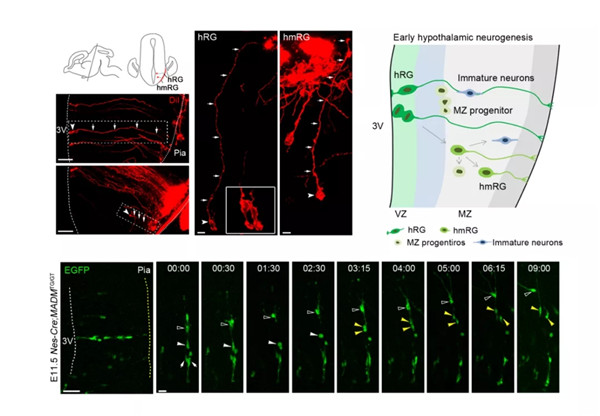Home> News
Chinese research group reveals cellular, molecular properties of neural progenitors in developing mammalian hypothalamus
Updated: 2020-08-19

A diagram shows the progenitor composition in the developing mammalian hypothalamus. [Photo/WeChat account of BSC]
A research group from the Institute of Biophysics at the Chinese Academy of Science, or CAS, recently reported their research results on the developmental characteristics of the hypothalamic neural progenitor. Their findings were contained in a paper entitled Cellular and molecular properties of neural progenitors in the developing mammalian hypothalamus -- published online on Aug 13 by the journal Nature Communications -- according to news on the WeChat public account of the Biophysical Society of China (BSC).
The hypothalamus is the central regulator of vital physiological homeostasis and behavior in mammalians. This complex brain region exhibits high conservation across mammals. In contrast to the cortex that is organized in a columnar structure, hypothalamic neurons form multiple functional nuclei are arrayed in a three-dimensional structure to regulate behavior. The organizational principles of cortical lamination have been well studied in the past 10 years.
In this research, hypothalamic radial glial (hRG) and hypothalamic mantle zone radial glial (hmRG) cells were found to be neural progenitors in the developing mammalian hypothalamus. The hmRG cells originated from hRG cells and produced neurons. During the early development of the hypothalamus, neurogenesis occurred in radial columns and is initiated from hRG cells. The radial glial fibers were oriented toward the locations of hypothalamic subregions, which acted as a scaffold for neuronal migration.
Using the single-cell RNA sequencing, the researchers revealed progenitor subtypes in the human developing hypothalamus and characterized specific progenitor genes. They demonstrated that HMGA2 was involved in E2F1 pathways, regulating the proliferation of progenitor cells. Different neuronal subtypes started to differentiate and expressed specific genes of the hypothalamic nucleus at gestational week 10. Moreover, researchers revealed the developmental conservation of nuclear structures and marker genes in the mouse and human hypothalamus. This data provided a basic understanding of neurogenesis and the regional formation of the non-laminated hypothalamus.
